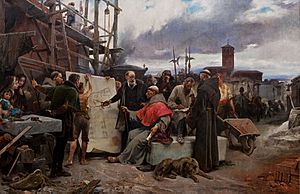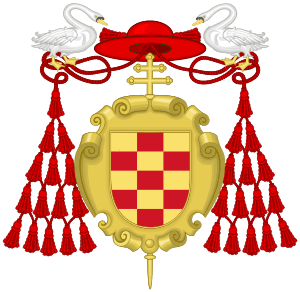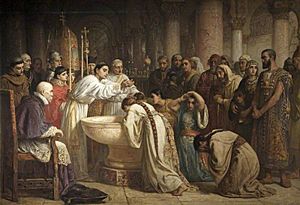Francisco Jiménez de Cisneros facts for kids
Quick facts for kids
The Most Eminent and Most Reverend
Cardinal Fray Francisco Jiménez de Cisneros
O.F.M.
|
|
|---|---|
 |
|
| 80th Archbishop of Toledo, Primate of Spain | |
| In office 20 February 1495 – 8 November 1517 |
|
| Preceded by | Cardinal González de Mendoza |
| Succeeded by | William de Croÿ |
| Governor of the Kingdom of Castile | |
| In office 23 January 1516 – 8 November 1517 |
|
| Monarch | Joanna I "The Mad" |
| Preceded by | Ferdinand II of Aragon, Governor of the Realm |
| Succeeded by | Charles I, co-monarch with his mother Joanna, |
| President of the Council of Regency of the Kingdom of Castile | |
| Preceded by | Philip "The Handsome", King of Castile, iure uxoris |
| Succeeded by | Ferdinand II of Aragon, Governor of the Realm |
| Personal details | |
| Born | 1436 Torrelaguna, Crown of Castile |
| Died | 8 November 1517 Roa de Duero, Crown of Castile |
Francisco Jiménez de Cisneros (1436 – November 8, 1517) was a very important Spanish cardinal, religious leader, and statesman. A statesman is someone who is skilled in governing a country. He started from humble beginnings but rose to great power.
He became a religious reformer and served twice as a regent of Spain. A regent is a person who governs a country when the king or queen is too young or absent. Cisneros was also a Cardinal, a Grand Inquisitor, and he helped promote crusades in North Africa. He founded the Complutense University, which is now the Complutense University of Madrid.
One of his biggest achievements was funding the Complutensian Polyglot Bible. This was the first printed Bible that showed the text in several languages side-by-side. He also helped publish the first printed prayer books for the Mozarabic Rite. This was a special Christian tradition in Spain.
Cardinal Cisneros lived during an exciting time in the history of Spain. He greatly influenced Spain during the rule of Ferdinand II of Aragon and Isabella I of Castile. During this period, Spain changed a lot and became very powerful. This led to the Spanish Golden Age, a time of great art and culture.
Rising to Power
Francisco Jiménez de Cisneros was born as Gonzalo Jiménez de Cisneros in Torrelaguna, Castile, in 1436. His parents were Alfonso Jiménez de Cisneros and María de la Torre. He studied law at Alcalá de Henares and Salamanca. In 1459, he went to Rome to work as a lawyer for the Church.
He returned to Spain in 1465 with a letter from the Pope. This letter said he should get the first available church position, called a benefice. This position was in Uceda. However, the Archbishop of Toledo, Alfonso Carrillo de Acuña, did not accept the Pope's letter. He wanted to give the position to one of his own followers.
When Cisneros insisted, he was put in prison for six years. He could have left at any time if he gave up his claim. But he held strong. In 1480, the Archbishop finally gave in and gave him the benefice. Cisneros quickly traded it for a chaplaincy in Sigüenza. There, he worked under Cardinal Pedro González de Mendoza, who soon made him a vicar general.
At Sigüenza, Cisneros was very successful. But in 1484, at 48 years old, he decided to become a Franciscan friar. He gave up all his belongings and changed his name from Gonzalo to Francisco. He joined the Franciscan friary of San Juan de los Reyes in Toledo. He lived a very strict and simple life, even sleeping on the bare ground. He continued this simple lifestyle even when he became very powerful.
Later, Cardinal Mendoza recommended him to Queen Isabella as her confessor in 1492. A confessor is a religious advisor. Cisneros accepted, but only if he could still live in his friary. This job was important because Isabella often asked her confessor for advice on state matters, not just religious ones.
In 1495, Cardinal Mendoza died. Queen Isabella secretly arranged for the Pope to name Cisneros as the new Archbishop of Toledo. This was the richest and most powerful church position in Spain. Cisneros also became the chancellor of Castile. Isabella tried to surprise him with the news, but Cisneros ran away! Isabella's messengers found him and convinced him to return. He resisted the appointment for six months but finally agreed after a second order from the Pope. Even with his new high rank, Cisneros kept his simple, strict lifestyle.
Reforms, Revolts, and Crusades

From his new position, Cisneros began to reform the Franciscan order in Spain. He made sure that ordained friars lived by strict rules. For example, they had to live in the parish where they worked and preach every Sunday. Many friars opposed these strict changes. By 1498, these reforms were expanded to other religious orders too. Cisneros, with the Queen's support, managed to enforce his strict rules.
In 1499, Cisneros went to Granada. There, he changed the way Hernando de Talavera was trying to convert the Muslim people to Christianity. Talavera wanted to convert them slowly and peacefully, by teaching them in their own language. But Cisneros believed in forced mass conversion. He ordered all Arabic manuscripts in Granada to be publicly burned, except for medical books. About 5,000 books were burned.
This angered the unconverted Muslims, called Mudéjares. They revolted in what became known as the First Rebellion of the Alpujarras. The revolt was put down with force. The Muslims were then given a choice: be baptized as Christians or be exiled from Spain. This was against the terms of Granada's surrender. Most chose baptism. By 1500, Cisneros reported that "there is now no one in the city who is not a Christian." However, this created a new problem that would only end much later with the expulsion of the Moriscos (Muslims who had converted to Christianity) from Spain in 1609.
Queen Isabella died in 1504. Ferdinand claimed to be regent, but Cisneros helped settle the disagreement. This led to Philip I of Castile becoming king of Castile. When Philip died in 1506, Ferdinand was in Naples. Cisneros set up a temporary government and stopped a plot by nobles to take over the throne. For his loyalty, Ferdinand made Cisneros the Grand Inquisitor for Castile and León in 1507. He also convinced the Pope to make Cisneros a Cardinal.
Cisneros then led an attack against the city of Oran in North Africa. This was a Muslim city. In 1505, a first expedition, paid for by Cisneros, captured the port of Mers El Kébir. In 1509, a large force, with Cisneros himself, sailed to Africa. The wealthy city of Oran was captured in one day. Cisneros returned to Spain. He wanted Ferdinand to support a larger crusade in North Africa, but Ferdinand was more interested in Italy.
Final Years
On January 23, 1516, King Ferdinand died. Cisneros became the regent of Castile for Charles, who was only sixteen years old and living in the Netherlands. Cisneros took strong control of the government. However, the powerful Castilian nobles and Charles's advisors from Flanders made Cisneros's job very difficult.
Cisneros agreed to Charles being proclaimed king. He made sure Charles's younger brother, Ferdinand, was safe. He also moved the courts to Madrid and created a standing army by training citizens. During his time as regent, he dealt with the Spanish conquest of Navarre. He ordered many fortresses in Navarre to be torn down. This was to prevent future rebellions against Spanish rule.
In September 1517, Charles landed in Laredo, Spain. Cisneros hurried to meet him. On the way, Cisneros became ill. Some people believe he might have been poisoned. While he was weak, he received a letter from Charles. The letter thanked him for his service and told him he could retire to his diocese. A few hours after this, Cardinal Cisneros died at Roa, on November 8, 1517. Some say he never even learned about the letter.
His Impact
Cardinal Cisneros was a brave and determined statesman. People described him as strict and unbending, even for his time. He always did what he believed was right, without caring much for his own comfort or others'. He was seen as honest and fair. He also founded and supported many helpful institutions in his diocese. His whole life was dedicated to the state or to religion. His only hobby was discussing theology.
He founded the university at Alcalá de Henares in 1500, and it opened in 1508. Cisneros paid for and supported this university himself. It became very famous. At one point, 7,000 students studied there. In 1836, the university moved to Madrid and was renamed the Complutense University of Madrid. The name "Complutense" means "from Alcalá." The original buildings in Alcalá de Henares were empty until a new university was created there in 1977.
Cisneros also published religious writings. He brought back the Mozarabic liturgy, a special way of worship, and created a chapel in Toledo where it could be used.
He is very well known for supporting the Complutensian Polyglot. This was the first printed Bible that showed the text in many languages side-by-side. It had three different versions of the Old Testament in parallel columns: Greek, Latin, and Hebrew. The Aramaic text was also included with its Latin translation. This allowed readers to compare all the translations at once. The New Testament had Greek and Latin versions side-by-side. The entire work filled five large books, plus a sixth book with a Hebrew dictionary. The project started in 1502. The New Testament was finished in 1514, and the whole Bible in 1517. The book was dedicated to Pope Leo X. Cisneros died just months after it was completed, so he never saw it published.
In 1884, Spanish colonists named a town after Cisneros. It was called Villa Cisneros, and it is now known as Dakhla in Western Sahara.
See also
 In Spanish: Francisco Jiménez de Cisneros para niños
In Spanish: Francisco Jiménez de Cisneros para niños





